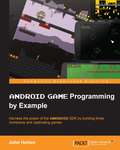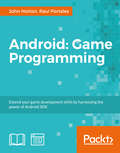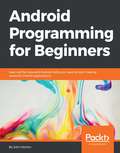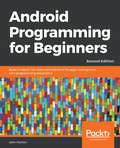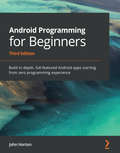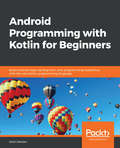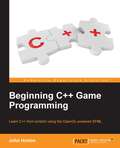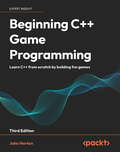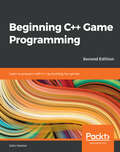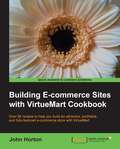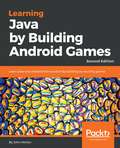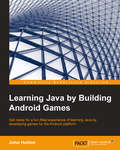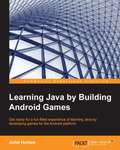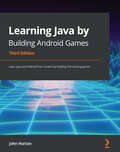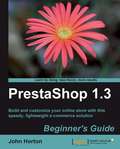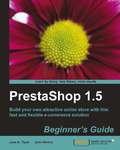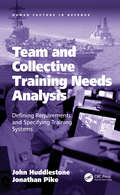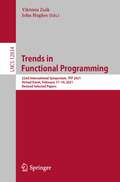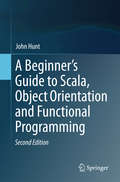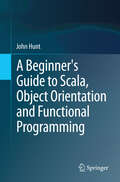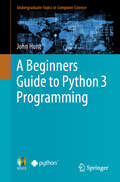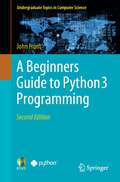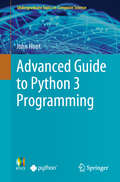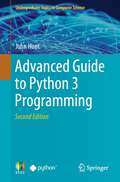- Table View
- List View
Android Game Programming by Example
by John Horton<P><P>Harness the power of the Android SDK by building three immersive and captivating games <P><P>About This Book <P><P>Implement the critical main game loop and structure your games to enable an array of advanced features <P><P>Animate your characters with sprite sheets, add multiple scrolling parallax backgrounds, and implement genuinely tough, playable levels in your games <P><P>Build super-smooth 60 frames per second with the help of this easy-to-follow, projects-based guide <P><P>Who This Book Is For <P><P>The book is best suited for existing Android or Java programmers who want to adapt their skills to make exciting Android games. <P><P>The book is also for determined readers who might have no Android, game programming or even Java experience, but a reasonable understanding of object oriented programming knowledge is assumed. <P><P>What You Will Learn <P><P>Build simple to advanced game engines for different types of game, with cool features such as sprite sheet character animation and scrolling parallax backgrounds <P><P>Design and implement genuinely challenging and playable levels <P><P>Implement the critical main game loop <P><P>Implement basic and advanced collision detection mechanics <P><P>Bring to life a challenging enemy AI <P><P>Make the math behind 2D rotation, velocity, and collisions simple <P><P>Run your game designs at 60 frames per second or better <P><P>Process multitouch screen input effectively and efficiently <P><P>Implement a multitude of other game features such as pickups, firing weapons, HUDs, generating and playing sound FX, scenery, level transition, high scores, and more <P><P>Implement a flexible and advanced game engine that uses OpenGL ES 2 for fast, smooth frame rates In Detail <P><P>Android gaming is a hot topic these days, but one of the few areas of technology that does not have an abundance of clear and useful documentation online. However, there is an ever-increasing demand for Android games. <P><P>This book will help you get up to speed with the essentials of game development with Android. The book begins by teaching you the setup of a game development environment on a fundamental level. Moving on, the book deals with concepts such as building a home screen UI, implementing game objects, and painting the scene at a fixed resolution. Gradually, it builds up to the implementation of a flexible and advanced game engine that uses OpenGL ES 2 for fast, smooth frame rates. This is achieved by starting with a simple game and gradually increasing the complexity of the three complete games built step by step. By the end of the book, you will have successfully built three exciting games over the course of three engrossing and insightful projects.
Android Game Programming: A Developer's Guide
by John Horton Raul PortalesExtend your game development skills by harnessing the power of Android SDK About This Book * Gain the knowledge to design and build highly interactive and amazing games for your phone and tablet from scratch * Create games that run at super-smooth 60 frames per second with the help of these easy-to-follow projects * Understand the internals of a game engine by building one and seeing the reasoning behind each of the components Who This Book Is For If you are completely new to Java, Android, or game programming, this book is for you. If you want to publish Android games for fun or for business and are not sure where to start, then this book will show you what to do, step by step, from the start. What You Will Learn * Set up an efficient, professional game development environment in Android Studio * Explore object-oriented programming (OOP) and design scalable, reliable, and well-written Java games or apps on almost any Android device * Build simple to advanced game engines for different types of game, with cool features such as sprite sheet character animation and scrolling parallax backgrounds * Implement basic and advanced collision detection mechanics * Process multitouch screen input effectively and efficiently * Implement a flexible and advanced game engine that uses OpenGL ES 2 to ensure fast, smooth frame rates * Use animations and particle systems to provide a rich experience * Create beautiful, responsive, and reusable UIs by taking advantage of the Android SDK * Integrate Google Play Services to provide achievements and leaderboards to the players In Detail Gaming has historically been a strong driver of technology, whether we're talking about hardware or software performance, the variety of input methods, or graphics support, and the Android game platform is no different. Android is a mature, yet still growing, platform that many game developers have embraced as it provides tools, APIs, and services to help bootstrap Android projects and ensure their success, many of which are specially designed to help game developers. Since Android uses one of the most popular programming languages, Java, as the primary language to build apps of all types, you will start this course by first obtaining a solid grasp of the Java language and its foundation APIs. This will improve your chances of succeeding as an Android app developer. We will show you how to get your Android development environment set up and you will soon have your first working game. The course covers all the aspects of game development through various engrossing and insightful game projects. You will learn all about frame-by-frame animations and resource animations using a space shooter game, create beautiful and responsive menus and dialogs, and explore the different options to play sound effects and music in Android. You will also learn the basics of creating a particle system and will see how to use the Leonids library. By the end of the course, you will be able to configure and use Google Play Services on the developer console and port your game to the big screen. This Learning Path combines some of the best that Packt has to offer in one complete, curated package. It includes content from the following Packt products: * Learning Java by Building Android Games by John Horton * Android Game Programming by Example by John Horton * Mastering Android Game Development by Raul Portales Style and approach This course is a step-by-step guide where you will learn to build Android games from scratch. It takes a practical approach where each project is a game. It starts off with simple arcade games, and then gradually the complexity of the games keep on increasing as you uncover the new and advanced tools that Android offers.
Android Programming for Beginners
by John HortonLearn all the Java and Android skills you need to start making powerful mobile applications About This Book * Kick-start your Android programming career, or just have fun publishing apps to the Google Play marketplace * A first-principles introduction to Java, via Android, which means you'll be able to start building your own applications from scratch * Learn by example and build three real-world apps and over 40 mini apps throughout the book Who This Book Is For Are you trying to start a career in programming, but haven't found the right way in? Do you have a great idea for an app, but don't know how to make it a reality? Or maybe you're just frustrated that "to learn Android, you must know java." If so, Android Programming for Beginners is for you. You don't need any programming experience to follow along with this book, just a computer and a sense of adventure. What You Will Learn * Master the fundamentals of coding Java for Android * Install and set up your Android development environment * Build functional user interfaces with the Android Studio visual designer * Add user interaction, data captures, sound, and animation to your apps * Manage your apps' data using the built-in Android SQLite database * Find out about the design patterns used by professionals to make top-grade applications * Build, deploy, and publish real Android applications to the Google Play marketplace In Detail Android is the most popular OS in the world. There are millions of devices accessing tens of thousands of applications. It is many people's entry point into the world of technology; it is an operating system for everyone. Despite this, the entry-fee to actually make Android applications is usually a computer science degree, or five years' worth of Java experience. Android Programming for Beginners will be your companion to create Android applications from scratch--whether you're looking to start your programming career, make an application for work, be reintroduced to mobile development, or are just looking to program for fun. We will introduce you to all the fundamental concepts of programming in an Android context, from the Java basics to working with the Android API. All examples are created from within Android Studio, the official Android development environment that helps supercharge your application development process. After this crash-course, we'll dive deeper into Android programming and you'll learn how to create applications with a professional-standard UI through fragments, make location-aware apps with Google Maps integration, and store your user's data with SQLite. In addition, you'll see how to make your apps multilingual, capture images from a device's camera, and work with graphics, sound, and animations too. By the end of this book, you'll be ready to start building your own custom applications in Android and Java. Style and approach With more than 40 mini apps to code and run, Android Programming for Beginners is a hands-on guide to learning Android and Java. Each example application demonstrates a different aspect of Android programming. Alongside these mini apps, we push your abilities by building three larger applications to demonstrate Android application development in context.
Android Programming for Beginners: Build in-depth, full-featured Android 9 Pie apps starting from zero programming experience, 2nd Edition
by John HortonLearn all the Java and Android skills you need to start making powerful mobile applications with practical and actionable stepsKey FeaturesKick-start your Android programming career, or just have fun publishing apps to the Google Play marketplaceA first-principles introduction to Java, via Android, which means you'll be able to start building your own applications from scratchLearn by example and build four real-world apps and dozens of mini-apps throughout the bookBook DescriptionAre you trying to start a career in programming, but haven't found the right way in? Do you have a great idea for an app, but don't know how to make it a reality? Or maybe you're just frustrated that in order to learn Android, you must know Java. If so, then this book is for you. This new and expanded second edition of Android Programming for Beginners will be your companion to create Android Pie applications from scratch. We will introduce you to all the fundamental concepts of programming in an Android context, from the basics of Java to working with the Android API. All examples use the up-to-date API classes, and are created from within Android Studio, the official Android development environment that helps supercharge your application development process. After this crash course, we'll dive deeper into Android programming and you'll learn how to create applications with a professional-standard UI through fragments and store your user's data with SQLite. In addition, you'll see how to make your apps multilingual, draw to the screen with a finger, and work with graphics, sound, and animations too. By the end of this book, you'll be ready to start building your own custom applications in Android and Java.What you will learnMaster the fundamentals of coding Java for Android PieInstall and set up your Android development environmentBuild functional user interfaces with the Android Studio visual designerAdd user interaction, data captures, sound, and animation to your appsManage your apps' data using the built-in Android SQLite databaseFind out about the design patterns used by professionals to make top-grade applicationsBuild, deploy, and publish real Android applications to the Google Play marketplaceWho this book is forThis book is for you if you are completely new to Java, Android, or programming and want to make Android applications. This book also acts as a refresher for those who already have experience of using Java on Android to advance their knowledge and make fast progress through the early projects.
Android Programming for Beginners: Build in-depth, full-featured Android apps starting from zero programming experience, 3rd Edition
by John HortonLearn the Java and Android skills you need to start developing powerful mobile applications with the help of actionable stepsKey FeaturesKick-start your Android programming career or just have fun publishing apps to the Google Play marketplaceGet a first principles introduction to using Java and Android and prepare to start building your own apps from scratchLearn by example by building four real-world apps and dozens of mini appsBook DescriptionDo you want to make a career in programming but don't know where to start? Do you have a great idea for an app but don't know how to make it a reality? Or are you worried that you'll have to learn Java programming to become an Android developer? Look no further! This new and expanded third edition of Android Programming for Beginners will be your guide to creating Android applications from scratch. The book starts by introducing you to all the fundamental concepts of programming in an Android context, from the basics of Java to working with the Android API. You'll learn with the help of examples that use up-to-date API classes and are created within Android Studio, the official Android development environment that helps supercharge your mobile application development process. After a crash course on the key programming concepts, you'll explore Android programming and get to grips with creating applications with a professional-standard UI using fragments and storing user data with SQLite. This Android Java book also shows you how you can make your apps multilingual, draw on the screen with a finger, and work with graphics, sound, and animations. By the end of this Android programming book, you'll be ready to start building your own custom applications in Android and Java.What you will learnUnderstand the fundamentals of coding in Java for AndroidInstall and set up your Android development environmentBuild functional user interfaces with the Android Studio visual designerAdd user interaction, data captures, sound, and animation to your appsManage your apps' data using the built-in Android SQLite databaseExplore the design patterns used by professionals to build top-grade applicationsBuild real-world Android applications that you can deploy to the Google Play marketplaceWho this book is forThis Android book is for you if you are completely new to Java, Android, or programming and want to get started with Android app development. If you have experience of using Java on Android, this book will serve as a refresher to help you advance your knowledge and make progress through the early projects covered in the book.
Android Programming with Kotlin for Beginners: Build Android apps starting from zero programming experience with the new Kotlin programming language
by John HortonBuild smart looking Kotlin apps with UI and functionality for the Android platform Key FeaturesStart your Android programming career, or just have fun publishing apps on Google Play marketplaceThe first-principle introduction to Kotlin through Android, to start building easy-to-use appsLearn by example and build four real-world apps and dozens of mini-appsBook DescriptionAndroid is the most popular mobile operating system in the world and Kotlin has been declared by Google as a first-class programming language to build Android apps. With the imminent arrival of the most anticipated Android update, Android 10 (Q), this book gets you started building apps compatible with the latest version of Android.It adopts a project-style approach, where we focus on teaching the fundamentals of Android app development and the essentials of Kotlin by building three real-world apps and more than a dozen mini-apps. The book begins by giving you a strong grasp of how Kotlin and Android work together before gradually moving onto exploring the various Android APIs for building stunning apps for Android with ease. You will learn to make your apps more presentable using different layouts. You will dive deep into Kotlin programming concepts such as variables, functions, data structures, Object-Oriented code, and how to connect your Kotlin code to the UI. You will learn to add multilingual text so that your app is accessible to millions of more potential users. You will learn how animation, graphics, and sound effects work and are implemented in your Android app.By the end of the book, you will have sound knowledge about significant Kotlin programming concepts and start building your own fully featured Android apps.What you will learnLearn how Kotlin and Android work togetherBuild a graphical drawing app using Object-Oriented Programming (OOP) principlesBuild beautiful, practical layouts using ScrollView, RecyclerView, NavigationView, ViewPager and CardViewWrite Kotlin code to manage an apps' data using different strategies including JSON and the built-in Android SQLite databaseAdd user interaction, data captures, sound, and animation to your appsImplement dialog boxes to capture input from the userBuild a simple database app that sorts and stores the user's dataWho this book is forThis book is for people who are new to Kotlin, Android and want to develop Android apps.It also acts as a refresher for those who have some experience in programming with Android and Kotlin.
Beginning C++ Game Programming
by John HortonLearn C++ from scratch using the OpenGL-powered SFMLAbout This BookThis book offers a fun way to learn modern C++ programming while building exciting 2D gamesThis beginner-friendly guide offers a fast-paced but engaging approach to game developmentDive headfirst into building a wide variety of desktop games that gradually increase in complexityIt is packed with many suggestions to expand your finished games that will make you think critically, technically, and creativelyWho This Book Is ForThis book is for those who have no C++ programming knowledge whatsoever and want to learn to build games or just use games as a more engaging way to learn C++. If you have aspirations of one day publishing a game on Steam or just want to have a load of fun while learning C++, then this book was written for you.What You Will LearnGet to know C++ from scratch while simultaneously learning about building gamesMake C++ game coding appear like it is something that any determined person can doGet a competent level knowledge of C++ programming.Build exciting games with a wide range of featuresGet ready to go and build your own unique gamesIn DetailThis book is all about offering you a fun introduction to the world of game programming and C++. It will begin by teaching you the programming basics such as variables, loops, and conditions using game-like mini apps.We then move on to build actual working games. Throughout the course of the book, you will learn to build three different styles of games comprising a frantic two-button-tapper, a zombie survival/shooter, and a multiplayer platformer. While building these games, you will learn some more C++ programming concepts such as OOP and data storage/complexity. We'll end by creating a multiplayer shooter game and will also introduce you to some of the advanced capabilities of C++ such as networking and advanced OOP.As the games gradually increase in complexity, you will explore some of the advanced capabilities of C++ as well as some exciting new game programming techniques.
Beginning C++ Game Programming: Learn C++ from scratch by building fun games
by John HortonGet to grips with programming and game development techniques using C++ libraries and Visual Studio 2022 with this updated edition of the bestselling series.Key FeaturesCreate fun games in C++, with this up-to-date guide covering the latest features of C++20 and VS2022Build clones of popular games such as a Timberman clone, a Pong game, a Zombie Survival Shooter, and a platform endless runner gameDiscover tips to expand your finished games by thinking critically, technically, and creativelyBook DescriptionAlways dreamed of creating your own games? With the third edition of Beginning C++ Game Programming, you can turn that dream into reality! This beginner-friendly guide is updated and improved to include the latest features of VS 2022, SFML, and modern C++20 programming techniques. You'll get a fun introduction to game programming by building four fully playable games of increasing complexity. You'll build clones of popular games such as Timberman, Pong, a Zombie survival shooter, and an endless runner. The book starts by covering the basics of programming. You'll study key C++ topics, such as object-oriented programming (OOP) and C++ pointers and get acquainted with the Standard Template Library (STL). The book helps you learn about collision detection techniques and game physics by building a Pong game. As you build games, you'll also learn exciting game programming concepts such as vertex arrays, directional sound (spatialization), OpenGL programmable shaders, spawning objects, and much more. You’ll dive deep into game mechanics and implement input handling, levelling up a character, and simple enemy AI. Finally, you'll explore game design patterns to enhance your C++ game programming skills. By the end of the book, you'll have gained the knowledge you need to build your own games with exciting features from scratch.What you will learnSet up your game project in VS 2022 and explore C++ libraries such as SFMLBuild games in C++ from the ground up, including graphics, physics, and input handlingImplement core game concepts such as game animation, game physics, collision detection, scorekeeping, and game soundImplement automatically spawning objects and AI to create rich and engaging experiencesLearn advanced game development concepts, such as OpenGL shaders, texture atlases, and parallax backgroundsScale and reuse your game code with modern game programming design patternsWho this book is forThis book is perfect for you if you have no C++ programming knowledge, you need a beginner-level refresher course, or you want to learn how to build games or just use games as an engaging way to learn C++. Whether you aspire to publish a game (perhaps on Steam) or just want to impress friends with your creations, you'll find this book useful
Beginning C++ Game Programming: Learn to program with C++ by building fun games
by John HortonGet to grips with programming techniques and game development using C++ libraries and Visual Studio 2019Key FeaturesLearn game development and C++ with a fun, example-driven approachBuild clones of popular games such as Timberman, Zombie Survival Shooter, a co-op puzzle platformer, and Space InvadersDiscover tips to expand your finished games by thinking critically, technically, and creativelyBook DescriptionThe second edition of Beginning C++ Game Programming is updated and improved to include the latest features of Visual Studio 2019, SFML, and modern C++ programming techniques. With this book, you’ll get a fun introduction to game programming by building five fully playable games of increasing complexity. You’ll learn to build clones of popular games such as Timberman, Pong, a Zombie survival shooter, a coop puzzle platformer and Space Invaders. The book starts by covering the basics of programming. You’ll study key C++ topics, such as object-oriented programming (OOP) and C++ pointers, and get acquainted with the Standard Template Library (STL). The book helps you learn about collision detection techniques and game physics by building a Pong game. As you build games, you’ll also learn exciting game programming concepts such as particle effects, directional sound (spatialization), OpenGL programmable shaders, spawning objects, and much more. Finally, you’ll explore game design patterns to enhance your C++ game programming skills. By the end of the book, you’ll have gained the knowledge you need to build your own games with exciting features from scratch.What you will learnSet up your game development project in Visual Studio 2019 and explore C++ libraries such as SFMLExplore C++ OOP by building a Pong gameUnderstand core game concepts such as game animation, game physics, collision detection, scorekeeping, and game soundUse classes, inheritance, and references to spawn and control thousands of enemies and shoot rapid-fire machine gunsAdd advanced features to your game using pointers, references, and the STLScale and reuse your game code by learning modern game programming design patternsWho this book is forThis book is perfect for you if you have no C++ programming knowledge, you need a beginner-level refresher course, or you want to learn how to build games or just use games as an engaging way to learn C++. Whether you aspire to publish a game (perhaps on Steam) or just want to impress friends with your creations, you’ll find this book useful.
Beginning C++20 Game Programming - Second Edition
by John HortonThis book is perfect for you if you have no C++ programming knowledge, you need a beginner-level refresher course, or you want to learn how to build games or just use games as an engaging way to learn C++. Whether you aspire to publish a game (perhaps on Steam) or just want to impress friends with your creations, you’ll find this book useful.
Building E-commerce Sites with VirtueMart Cookbook
by John HortonWritten in a friendly, recipe-based style, this practical cookbook will show you how to create, maintain and customize attractive eCommerce solutions with ease.This book is written for anyone who is interested in building eCommerce solutions with VirtueMart. If you have little to no experience with eCommerce this book will show you how to overcome any problem no matter how complex it appears. Experienced site builders and administrators will also find the solutions this cookbook offers useful. Basic HTML and CSS would be beneficial.
Learning Java by Building Android Games: Learn Java and Android from scratch by building six exciting games, 2nd Edition
by John HortonGet ready for a fun-filled experience of learning Java by developing games for the Android platformKey FeaturesLearn Java, Android, and object-oriented programming from scratchBuild games including Sub Hunter, Retro Pong, Bullet Hell, Classic Snake, and a 2D Scrolling ShooterCreate and design your own games, such as an open-world platform gameBook DescriptionAndroid is one of the most popular mobile operating systems presently. It uses the most popular programming language, Java, as the primary language for building apps of all types. However, this book is unlike other Android books in that it doesn’t assume that you already have Java proficiency.This new and expanded second edition of Learning Java by Building Android Games shows you how to start building Android games from scratch. The difficulty level will grow steadily as you explore key Java topics, such as variables, loops, methods, object oriented programming, and design patterns, including code and examples that are written for Java 9 and Android P. At each stage, you will put what you’ve learned into practice by developing a game. You will build games such as Minesweeper, Retro Pong, Bullet Hell, and Classic Snake and Scrolling Shooter games. In the later chapters, you will create a time-trial, open-world platform game. By the end of the book, you will not only have grasped Java and Android but will also have developed six cool games for the Android platform.What you will learnSet up a game development environment in Android StudioImplement screen locking, screen rotation, pixel graphics, and play sound effectsRespond to a player’s touch, and program intelligent enemies who challenge the player in different waysLearn game development concepts, such as collision detection, animating sprite sheets, simple tracking and following, AI, parallax backgrounds, and particle explosionsAnimate objects at 60 frames per second (FPS) and manage multiple independent objects using Object-Oriented Programming (OOP)Understand the essentials of game programming, such as design patterns, object-oriented programming, Singleton, strategy, and entity-component patternsLearn how to use the Android API, including Activity lifecycle, detecting version number, SoundPool API, Paint, Canvas, and Bitmap classes Build a side-scrolling shooter and an open world 2D platformer using advanced OOP concepts and programming patternsWho this book is forLearning Java by Building Android Games is for you if you are completely new to Java, Android, or game programming and want to make Android games. This book also acts as a refresher for those who already have experience of using Java on Android or any other platform without game development experience.
Learning Java by Building Android Games
by John HortonIf you are completely new to either Java, Android, or game programming and are aiming to publish Android games, then this book is for you. This book also acts as a refresher for those who already have experience in Java on another platforms or other object-oriented languages.
Learning Java by Building Android Games
by John Horton<P><P>Key Features <P><P>Acquaint yourself with Java and object-oriented programming, from zero previous experience <P><P>Build four cool games for your phone and tablet, from retro arcade-style games to memory and education games, and gain the knowledge to design and create your own games too <P><P>Walk through the fundamentals of building games and use that experience as a springboard to study advanced game development or just have fun <P><P>Book Description <P><P>Android is the fastest growing operating system (OS) with one of the largest installed bases of any mobile OS. Android uses one of the most popular programming languages, Java, as the primary language for building apps of all types. So, you should first obtain a solid grasp of the Java language and its foundation APIs to improve the chances of succeeding as an Android app developer. <P><P>This book will show you how to get your Android development environment set up and you will soon have your first working game. The difficulty level grows steadily with the introduction of key Java topics such as loops, methods, and OOP. You'll then use them in the development of games. You will learn how to build a math test game, a Simon-like memory game, a retro pong-style game, and for the grand finale, a Snake-style, retro arcade game with real Google Play leaderboards and achievements. The book has a hands-on approach and is packed with screenshots. <P><P>What You Will Learn <P><P>Set up an efficient, professional game development environment in Android Studio <P><P>Build your very own Android UI using easy to-use tools in Android Studio <P><P>Add real-time interaction with Java threads and implement locking/handling screen rotation, pixel graphics, clicks, animation, sound FX, and many other features in your games <P><P>Explore object-oriented programming (OOP) and design scalable, reliable, and well-written Java games or apps on almost any Android device <P><P>Build and deploy a graphical pong-style game using advanced OOP concepts <P><P>Explore APIs and implement advanced features such as online leaderboards and achievements using Google game services Make your game compelling to be the next big hit on Google Play market with a content update strategy and in-game marketing
Learning Java by Building Android Games: Learn Java and Android from scratch by building five exciting games, 3rd Edition
by John HortonGet ready to learn Java the fun way by developing games for the Android platform with this new and updated third editionKey FeaturesLearn Java, Android, and object-oriented programming from scratchFind out how to build games including Sub Hunter, Retro Pong, Bullet Hell, Classic Snake, and Scrolling ShootersCreate and design your own games by learning all the concepts that a game developer must knowBook DescriptionAndroid is one of the most popular mobile operating systems today. It uses the most popular programming language, Java, as one of the primary languages for building apps of all types. Unlike most other Android books, this book doesn't assume that you have any prior knowledge of Java programming, instead helps you get started with building Android games as a beginner. This new, improved, and updated third edition of Learning Java by Building Android Games helps you to build Android games from scratch. Once you've got to grips with the fundamentals, the difficulty level increases steadily as you explore key Java topics, such as variables, loops, methods, object-oriented programming (OOP), and design patterns while working with up-to-date code and supporting examples. At each stage, you'll be able to test your understanding by implementing the concepts that you've learned to develop a game. Toward the end, you'll build games such as Sub Hunter, Retro Pong, Bullet Hell, Classic Snake, and Scrolling Shooter. By the end of this Java book, you'll not only have a solid understanding of Java and Android basics but will also have developed five cool games for the Android platform.What you will learnSet up a game development environment in Android StudioRespond to a player's touch and program intelligent enemies who can challenge the player in different waysExplore collision detection, sprite sheets animation, simple tracking and following, AI, parallax backgrounds, and particle explosionsAnimate objects at 60 FPS and manage multiple independent objects using OOPWork with design patterns such as OOP, singleton, strategy, and entity-componentWork with the Android API, the SoundPool API, Paint, Canvas, Bitmap classes, and detect version numbersWho this book is forLearning Java by Building Android Games is for anyone who is new to Java, Android, or game programming and wants to develop Android games. The book will also serve as a refresher for those who already have experience using Java on Android or any other platform but are new to game development.
PrestaShop 1.3 Beginner's Guide
by John HortonThe book is structured so that following the chapters in order leads to building a fully functioning and live trading PrestaShop. Guidance is also given should you wish to learn or practice your skills in an offline, non-trading environment. Every chapter contains clearly structured and illustrated step-by-step explanation to achieve the goals discussed. Nothing is left for readers to work out themselves, but it would be very simple for them to use the information to go beyond the specific tutorials, should they wish to do so. There is optional additional reading, including more than a dozen specifically written downloadable e-books made available on the book's support website just for readers of PrestaShop 1.3 Beginners Guide. This book is for anybody who wants a fully functioning e-commerce store using PrestaShop. You do not have to have any previous knowledge of PrestaShop or any aspect of e-commerce or business in general. If you do, then you will probably find this guide really valuable as well. The book covers all you need to know about starting your own e-commerce business.
PrestaShop 1.5 Beginner’s Guide
by John Horton Jose A. TizonThis book is written in a friendly voice with lots of tips, tricks, and screenshots to help you set up, extend, and personalize your own online shop. If you want to start your own e-commerce business, then this book will help you do that.This book is for people who are interested in creating an online shop. Basic HTML and CSS skills would be beneficial but are not required as we will provide you with all the code and know-how you need.
Team and Collective Training Needs Analysis: Defining Requirements and Specifying Training Systems (Human Factors in Defence)
by Jonathan Pike John HuddlestoneMilitary capability is delivered operationally at a team and collective level, be it a unit as small as a squad or section, or as large as a maritime task group. Modern military forces are required to deal with a potentially wide range of missions frequently involving multiple alliance partners, within a geopolitical environment which can seem to change rapidly. Individual performance, while being important, is not the primary determinant of mission success - force integration, interoperability, adaptability and teamwork are key factors. Team and collective training which fully addresses these factors is fundamental to the development and delivery of military capability. As a consequence, the requirement to determine training requirements and specify effective systems for the delivery of team and collective training is critical to operational success. Training Needs Analysis (also known as Front End Analysis), is a well-established methodology for analysing training requirements and specifying training solutions used extensively by the UK and its NATO partners. However, the analytical techniques employed are optimised for individual training, with little guidance being offered on its application in the team and collective context. Team and Collective Training Needs Analysis (TCTNA) has been developed to close this methodological gap. It addresses the issues of the relationship of individual and team tasks, teamwork, command and control, task and training environments, scenario definition, instructional strategy, team training approaches, instructional functions, and wide-ranging organisational and procurement considerations. Part One of the book develops an integrated set of models which underpin the analytical approach presented in Part Two. Worked examples and case studies illustrate the application of the approach. Between 2005 and 2015 the authors worked on numerous training-related research projects at Cranfield University and Coventry University for the Human Factors Integration Defence Technology Centre and the Defence Human Capability Science and Technology Centre on behalf of the Defence Science and Technology Laboratory, UK Ministry of Defence.
Trends in Functional Programming: 22nd International Symposium, TFP 2021, Virtual Event, February 17–19, 2021, Revised Selected Papers (Lecture Notes in Computer Science #12834)
by John Hughes Viktória ZsókThis book constitutes revised selected papers from the 22nd International Symposium on Trends in Functional Programming, TFP 2021, which was held virtually in February 2020. The 6 full papers presented in this volume were carefully reviewed and selected from 18 submissions. They were organized in topical sections about nested parallelism, semantics, task-oriented programming and modelling, translating, proving functional programs. Chapter ‘Dataset Sensitive Autotuning of Multi-Versioned Code based on Monotonic Properties’ is available open access under a Creative Commons Attribution 4.0 International License via link.springer.com. Chapter ‘High-level Modelling for Typed Functional Programming’ is available open access under a Creative Commons Attribution 4.0 International License via link.springer.com.
A Beginner's Guide to Scala, Object Orientation and Functional Programming
by John HuntScala is now an established programming language developed by Martin Oderskey and his team at the EPFL. The name Scala is derived from Sca(lable) La(nguage). Scala is a multi-paradigm language, incorporating object oriented approaches with functional programming. Although some familiarity with standard computing concepts is assumed (such as the idea of compiling a program and executing this compiled from etc.) and with basic procedural language concepts (such as variables and allocation of values to these variables) the early chapters of the book do not assume any familiarity with object orientation nor with functional programming These chapters also step through other concepts with which the reader may not be familiar (such as list processing). From this background, the book provides a practical introduction to both object and functional approaches using Scala. These concepts are introduced through practical experience taking the reader beyond the level of the language syntax to the philosophy and practice of object oriented development and functional programming. Students and those actively involved in the software industry will find this comprehensive introduction to Scala invaluable.
A Beginner's Guide to Scala, Object Orientation and Functional Programming
by John HuntScala is a new programming language developed by Martin Odersky and his team at the EPFL. The name Scala is derived from Sca(lable) La(nguage). Scala is a multi-paradigm language, incorporating object oriented approaches with functional programming. Although some familiarity with standard computing concepts is assumed (such as the idea of compiling a program and executing this compiled form, etc.) and with basic procedural language concepts (such as variables and allocation of values to variables) the early chapters of the book do not assume any familiarity with object orientation nor functional programming. These chapters also step through other concepts with which the reader may not be familiar (such as list processing). From this background, John Hunt provides a practical introduction to object and functional technology using Scala, one of the newest and most interesting programming languages available. A variety of concepts are introduced through practical experience taking the reader beyond the level of the language syntax to the philosophy and practice of object-oriented development and functional programming. Students, and those actively involved in the software industry will find this comprehensive introduction to Scala and to object orientation and functional programming, invaluable.
A Beginners Guide to Python 3 Programming (Undergraduate Topics in Computer Science)
by John HuntThis textbook on Python 3 explains concepts such as variables and what they represent, how data is held in memory, how a for loop works and what a string is. It also introduces key concepts such as functions, modules and packages as well as object orientation and functional programming. Each section is prefaced with an introductory chapter, before continuing with how these ideas work in Python. Topics such as generators and coroutines are often misunderstood and these are explained in detail, whilst topics such as Referential Transparency, multiple inheritance and exception handling are presented using examples. A Beginners Guide to Python 3 Programming provides all you need to know about Python, with numerous examples provided throughout including several larger worked case studies illustrating the ideas presented in the previous chapters.
A Beginners Guide to Python 3 Programming (Undergraduate Topics in Computer Science)
by John HuntThis textbook is aimed at readers who have little or no knowledge of computer programming but want to learn to program in Python. It starts from the very basics including how to install your Python environment, how to write a very simple program and run it, what a variable is, what an if statement is, how iteration works using for and while loops as well as important key concepts such as functions, classes and modules. Each subject area is prefaced with an introductory chapter, before continuing with how these ideas work in Python. The second edition has been completely updated for the latest versions of Python including Python 3.11 and Python 3.12. New chapters have been added such as those that consider where and how Python is used, the use of Frozensets, how data can be sorted, enumerated types in Python, structural pattern matching and how (and why) Python Virtual Environments are configured. A new chapter ‘The Python Bites back’ is introduced to present the fourteen most common / biggest gotchas for someone new to Python. Other sections have been updated with new features such as Exception Groups, string operations and dictionary operations. A Beginners Guide to Python 3 Programming second Edition provides all you need to know about Python, with numerous examples provided throughout including several larger worked case studies illustrating the ideas presented in the previous chapters.
Advanced Guide to Python 3 Programming (Undergraduate Topics in Computer Science)
by John HuntAdvanced Guide to Python 3 Programming delves deeply into a host of subjects that you need to understand if you are to develop sophisticated real-world programs. Each topic is preceded by an introduction followed by more advanced topics, along with numerous examples, that take you to an advanced level. There are nine different sections within the book covering Computer Graphics (including GUIs), Games, Testing, File Input and Output, Databases Access, Logging, Concurrency and Parallelism, Reactive programming, and Networking. Each section is self-contained and can either be read on its own or as part of the book as a whole. This book is aimed at the those who have learnt the basics of the Python 3 language but want to delve deeper into Python’s eco system of additional libraries and modules, to explore concurrency and parallelism, to create impressive looking graphical interfaces, to work with databases and files and to provide professional logging facilities.
Advanced Guide to Python 3 Programming (Undergraduate Topics in Computer Science)
by John HuntAdvanced Guide to Python 3 Programming 2nd Edition delves deeply into a host of subjects that you need to understand if you are to develop sophisticated real-world programs. Each topic is preceded by an introduction followed by more advanced topics, along with numerous examples, that take you to an advanced level.This second edition has been significantly updated with two new sections on advanced Python language concepts and data analytics and machine learning. The GUI chapters have been rewritten to use the Tkinter UI library and a chapter on performance monitoring and profiling has been added. In total there are 18 new chapters, and all remaining chapters have been updated for the latest version of Python as well as for any of the libraries they use. There are eleven sections within the book covering Python Language Concepts, Computer Graphics (including GUIs), Games, Testing, File Input and Output, Databases Access, Logging, Concurrency and Parallelism, Reactive Programming, Networking and Data Analytics. Each section is self-contained and can either be read on its own or as part of the book as a whole. It is aimed at those who have learnt the basics of the Python 3 language but wish to delve deeper into Python’s eco system of additional libraries and modules.
